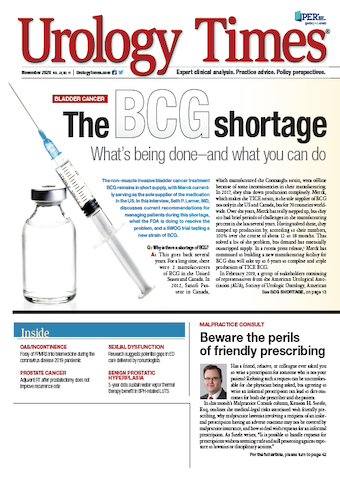Publication
Article
Urology Times Journal
Foray of FPMRS into telemedicine during the coronavirus pandemic
Author(s):
"Patients undergoing midurethral sling placement are ideal for postoperative virtual visits," writes Priya Padmanabhan, MD, MPH.
Priya Padmanabhan, MD, MPH

The coronavirus disease 2019 (COVID-19) pandemic has triggered a rapid rise in the use of telemedicine across all specialties, including female pelvic medicine and reconstructive surgery (FPMRS). In an attempt to flatten the curve of transmission, we have made radical changes in the way we provide quality, comprehensive care for our patients.
Telemedicine has classically been useful for providing behavioral therapy, conservative and pharmacological treatment. In these cases, treatment is based on symptom improvement and not physical exam. FPMRS encompasses a spectrum of conditions with varied treatments. An initial challenge exists in identifying the appropriate patients for postoperative telemedicine visits. The nature of the condition, the follow-up questions, and the necessary tests dictate the need for an office-based postoperative visit. For example, subjective questions may assess the response to a midurethral sling. This is not the case, however, for recovery after genitourinary fistula surgery.
The effectiveness of virtual postoperative tension-free vaginal tape visits was first highlighted by Jefferis et al.1 Recently, in an international, prospective, multi-institutional, randomized control trial, the use of telemedicine in the early postoperative follow-up period after midurethral sling was presented at the 2020 American Urological Association Virtual Experience.2 A total of 237 patients were randomized 1:1 to telemedicine or office-based 3-week follow-up. Seventy percent of patients were equally “very satisfied” with their surgical outcomes. Predictors of satisfaction included non-Caucasian ethnicity and no college-level education. Sixteen (13.2%) of the patients requested crossover to office-based visits. Age greater than 65 years was the only predictor of this crossover. The telemedicine group was the most adherent to 3- to 5-month office-based follow-up.
Patients undergoing midurethral sling placement are ideal for postoperative virtual visits. Clinicians may assess success in most cases with subjective questions and quality-of-life questionnaires and, again through appropriate questions, easily identify irregularities. Complications such as an obstructing sling or mesh erosion create symptoms that a patient will easily notice. In such cases, clinicians may ask the patient to come in for a physical exam and testing.
The use of early virtual follow-up provides a balance of patient satisfaction, clinical utilization, and resource conservation. Reimbursement is based on a 90-day global period post sling. With equal satisfaction of both types of visits, a 3- to 5-month office-based visit is beneficial to the patient and clinic. Prior to COVID-19, only 15% of providers reported using telehealth regularly. This was related to obvious barriers that are rapidly being overcome, including lack of training, gaps in technology access and familiarity, apprehension around adoption of the new platform, and reimbursement.
With the foray into telemedicine during the COVID-19 pandemic, we have witnessed rapid growth in our knowledge and patient accessibility. It is clear that virtual visits are a viable option, well liked by patients and physicians alike. Both virtual and office platforms may provide excellent care without compromising quality. The changes in reimbursements are promising. Time will tell how FPMRS further utilizes telemedicine.
Padmanabhan, a member of the Urology Times® Editorial Council, is a professor of urology at Oakland University William Beaumont School of Medicine, Royal Oak, Michigan.
References
1. Jefferis H, Muriithi F, White B, et al. Telephone follow-up after day case tension-free vaginal tape insertion. Int Urogynecol J. 2016;27(5):787-790. doi:10.1007/s00192-015-2891-6
2. Derisavifard S, Rueb J, Kocher N, et al. Telemedicine optimizes early post-operative follow up after synthetic mid-urethral sling (MUS): a randomized multi-institutional control trial. Paper presented at: 2020 American Urological Association Virtual Experience; June 27-28, 2020

2 Commerce Drive
Cranbury, NJ 08512
All rights reserved.





